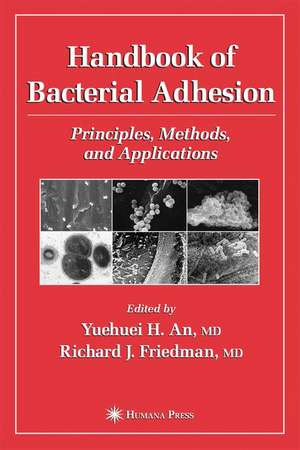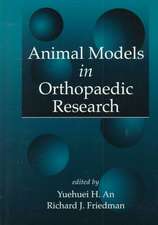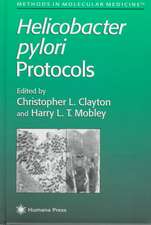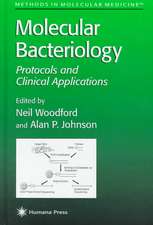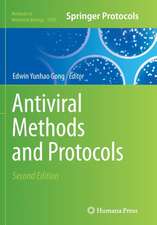Handbook of Bacterial Adhesion: Principles, Methods, and Applications
Editat de Yuehuei H. An, Richard J. Friedmanen Limba Engleză Hardback – 21 ian 2000
| Toate formatele și edițiile | Preț | Express |
|---|---|---|
| Paperback (1) | 1242.21 lei 6-8 săpt. | |
| Humana Press Inc. – 5 noi 2010 | 1242.21 lei 6-8 săpt. | |
| Hardback (1) | 1250.25 lei 6-8 săpt. | |
| Humana Press Inc. – 21 ian 2000 | 1250.25 lei 6-8 săpt. |
Preț: 1250.25 lei
Preț vechi: 1524.69 lei
-18% Nou
Puncte Express: 1875
Preț estimativ în valută:
239.31€ • 260.03$ • 201.15£
239.31€ • 260.03$ • 201.15£
Carte tipărită la comandă
Livrare economică 21 aprilie-05 mai
Preluare comenzi: 021 569.72.76
Specificații
ISBN-13: 9780896037946
ISBN-10: 0896037940
Pagini: 644
Ilustrații: XVII, 644 p. 87 illus.
Dimensiuni: 178 x 254 x 37 mm
Greutate: 1.38 kg
Ediția:2000
Editura: Humana Press Inc.
Colecția Humana
Locul publicării:Totowa, NJ, United States
ISBN-10: 0896037940
Pagini: 644
Ilustrații: XVII, 644 p. 87 illus.
Dimensiuni: 178 x 254 x 37 mm
Greutate: 1.38 kg
Ediția:2000
Editura: Humana Press Inc.
Colecția Humana
Locul publicării:Totowa, NJ, United States
Public țintă
ResearchCuprins
I — Mechanisms of Microbial Adhesion and Biofilm Formation.- 1. Mechanisms of Bacterial Adhesion and Pathogenesis of Implant and Tissue Infections.- 2. Molecular Basis of Bacterial Adhesion.- 3. Molecular Genetics of Bacterial Adhesion and Biofouling.- 4. Factors Influencing Bacterial Adhesion.- 5. Nonspecific Staphylococcus epidermidis Adhesion: Contributions of Biomaterial Hydrophobicity and Charge.- 6. Effects of Surface Roughness and Free Energy on Oral Bacterial Adhesion.- II — General Considerations and Methods for Studying Microbial Adhesion and Biofilm.- 7. Basic Equipment and Microbiological Techniques for Studying Bacterial Adhesion.- 8. General Considerations for Studying Bacterial Adhesion to Biomaterials.- 9. Laboratory Culture and Analysis of Microbial Biofilms.- 10. Monitoring the Organization of Microbial Biofilm Communities.- 11. Models and Measurement of Bacterial Growth Rates on Polymers.- 12. Analysis of Gene Expression in Biofilm Bacteria.- III — Techniques for Studying Microbial Adhesion and Biofilm.- 13. Methods for Evaluating Attached Bacteria and Biofilms: An Overview.- 14. Evaluating Adherent Bacteria and Biofilm Using Electron Microscopy.- 15. Confocal Laser Scanning Microscopy for Examination of Microbial Biofilms.- 16. Quantitation of Bacterial Adhesion to Biomaterials Using Radiolabeling Techniques.- 17. Evaluating Adherent Bacteria and Biofilm Using Biochemical and Immunochemical Methods.- 18. Evaluating Bacterial Adhesion Using Atomic Force Microscopy.- 19. Direct Measurement of Long-Range Interaction Forces Between a Single Bacterium and a Substrate Using an Optical Trap.- IV — Studying Microbial Adhesion to Biomaterials.- 20. Staphylococcal Factors Involved in Adhesion and Biofilm Formation on Biomaterials.- 21. StudyingBacterial Adhesion to Irregular or Porous Surfaces.- 22. Studying Bacterial Colonization of Tubular Medical Devices.- 23. Studying Plaque Biofilms on Various Dental Surfaces.- 24. Studying Bacterial Adhesion to Biliary Stents.- 25. Studying Bacterial Adhesion to Hydrogel Contact Lenses.- 26. In Vivo Models for Studying Staphylococcal Adhesion to Biomaterials.- V — Studying Microbial Adhesion to Host Tissue.- 27. Characterization of Staphylococcal Adhesins for Adherence to Host Tissues.- 28. Studying Bacterial Adhesion to Tooth Surfaces.- 29. Studying Bacterial Adhesion to Respiratory Mucosa.- 30. Studying Bacterial Adhesion to Endothelial Cells.- 31. Studying Bacterial Adhesion to Gastric Epithelium.- 32. Studying Bacterial Adhesion in the Urinary Tract.- 33. Studying Candida albicans Adhesion.- 34. Studying Bacterial Adhesion to Cultured Cells.- VI — Strategies for Prevention of Microbial Adhesion.- 35. Strategies for Preventing Group A Streptococcal Adhesion and Infection.- 36. Changing Material Surface Chemistry for Preventing Bacterial Adhesion.- 37. Antimicrobial Agent Incorporation for Preventing Bacterial Adhesion.- 38. Studying Bacterial Adhesion to Antibiotic Impregnated Polymethylmethacrylate.- 39. Macromolecule Surface Coating for Preventing Bacterial Adhesion.- Appendix 1.
Recenzii
"Techniques used to study adhesion of microbes to a wide variety of different surfaces of medical significance are presented. . .The diversity of different microbe-surface interactions covered is probably the most unique aspect of the text. . .This book is a broad survey of techniques and approaches used to study bacterial adhesion, with a heavy emphasis on topics of medical significance. The emphasis on approaches and techniques to study adhesion distinguishes this book from others that deal with the mechanisms of bacterial adhesion. . . the text will provide a useful resource for researchers studying bacterial adhesion."-Doody's Health Sciences Book Review Journal
Textul de pe ultima copertă
In the Handbook of Bacterial Adhesion: Principles, Methods, and Applications, Yuehuei An, MD, and Richard Friedman, MD, assemble the first comprehensive treatment of bacterial adhesion, with major concentration on the powerful experimental methods for its study in biomaterials and host tissues. Written by acknowledged experts in the field, these detailed techniques facilitate the study of implant infections in a wide range of devices, including orthopedic prostheses, cardiovascular devices, cerebrospinal fluid shunts and extradural catheters, urological catheters and stents, oral and maxillofacial implants, and even contact lenses. Methods for the study of microbial adhesion to such tissues as respiratory and intestinal mucosa, the urinary tract, and teeth are also included, as are numerous diagrams, tables, line drawings, and photographs to illuminate and clarify the text.
Comprehensive and eminently practical, the Handbook of Bacterial Adhesion: Principles, Methods, and Applications offers biomedical scientists and bioengineering researchers an all-in-one experimental guide to today's best techniques for understanding the nature, mechanisms, and prevention of bacterial adhesion.
Comprehensive and eminently practical, the Handbook of Bacterial Adhesion: Principles, Methods, and Applications offers biomedical scientists and bioengineering researchers an all-in-one experimental guide to today's best techniques for understanding the nature, mechanisms, and prevention of bacterial adhesion.
Caracteristici
Includes supplementary material: sn.pub/extras
